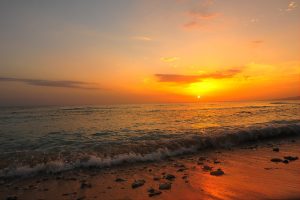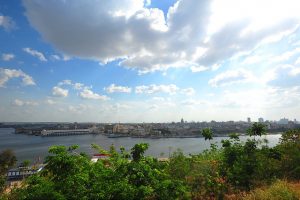Nestled in-between the bejewelled bosom of the Caribbean and the neighbouring nexus of Central America, Cuba is an island nation 90 miles off the coast of Florida, famed for its anti-establishment old-school cool, vibrant people and bad-ass cocktails (indeed, Hemingway’s two favourite watering holes in Havana, La Floridita—for a daiquiri—and La Bodeguita del Medio—for a mojito—still stand today.
After a long and confusing political history, hallmarked by varying ebbs and flows of tension with the US, tourists are now allowed to freely enter the country to see the remnants of varying colonial powers that have left their shell on the small island nation. Imagine grand colonial architecture, rustic with age, alongside old beaten-up classic American cars and the scent of fresh fruit, tobacco, and rum wafting through the streets.
While this may sound like a tourist’s paradise, some tourists wishing to visit Cuba in recent years haven’t had an easy ride. February 7th, 2012 marked the 50th anniversary of the US embargo against Cuba, known by Cubans as “el bloqueo”. This consisted of economic sanctions against Cuba and restrictions on Cuban travel. To cut a very long story short, April 1961 saw the Cuban government declare itself Marxist and socialist and aligned with the Soviet Union. Unsurprisingly, America was rather miffed. In fact, it threw what some would argue as a full blown toddler-in-the-cereal-isle tantrum, climaxing on September 4, 1961, with Washington passing measures prohibiting US aid and trade to Cuba (but not before John F Kennedy hightailed his secretary over there to buy 1,200 Cuban cigars).
 And just like that, an embargo that would take half a century to resolve was born. At this time, all Cubans received less than $20 a month—barely enough to survive. But, by 1991, the Soviet Union dissolved and its assistance to Cuba ended. Loss of Soviet financial support and the continuing U.S. economic embargo resulted in crippling poverty. Cuba had ostensibly been shafted by the two global superpowers.
And just like that, an embargo that would take half a century to resolve was born. At this time, all Cubans received less than $20 a month—barely enough to survive. But, by 1991, the Soviet Union dissolved and its assistance to Cuba ended. Loss of Soviet financial support and the continuing U.S. economic embargo resulted in crippling poverty. Cuba had ostensibly been shafted by the two global superpowers.
Luckily, the small trickles of tourism from predominantly Canada and parts of Europe were steady enough to cushion Cuba’s crumbling economy through the hardest times, but was restricted enough that Cuba was almost totally preserved in a surreal time warp. It is now one of the last remaining nations in the northern hemisphere where you won’t find a Starbucks every 100 feet, or swarms of gawking, fanny-pack, selfie-stick donning tourists violating your hotel. In the absence of a US consumerist presence, Cuba has largely remained a retro relic of the past and a place of great intrigue for the rest of the world who couldn’t imagine life without Big Macs and mochafluffyskinnycrappaccinos. However, the 17th of December 2014 was to put this under trial. Obama announced the implementation of his long-fought campaign to ease political tensions, and with it, the easing of visa restrictions for US citizens, thus allowing Americans to visit the island for any of a dozen specific reasons including family, educational, or religious visits without first obtaining a special license from the U.S. Whether for better or worse, Cuba put its head between its knees and braced for impact.
According to a report in the New York Times, bookings to Cuba for one American tour company jumped 57 per cent in the January after the announcement. In February, they increased 187 per cent. The following month, just shy of 250 per cent. Many Cubans—particularly those in the hospitality sector—rejoiced at this seismic shift in tourism to the country. However, anywhere on Earth would be slightly intimidated by 250 percent more Americans, let alone for a nation state with a limited internal infrastructure and only 11 million people, especially when amongst the first Americans to enjoy the new visa policy are The Kardashians in a hot pink convertible, tweeting Puerto Rican slang and posing under revolutionary Fidel Castro quotes.
Kardashians aside, the associated development and increased number of visitors in certain regions of Cuba has already threatened coastal areas, as new beachfront hotels are constructed to accommodate the new influx of visitors. This is of particular concern because some of these beaches are prime habitats for a variety of rare species. Data from neighbouring islands on the tourism industry’s impact on the environment show that the effects can be significant. As a direct result from the strains of tourism, environmental effects range from damage to coral reefs to depletion of water tables.
 Indeed, according to research from the University of Pennsylvania, “there are not [currently] enough five-star hotels to accommodate an explosion of American tourists”. This is also an issue for many private homes which are being turned into hotels or “casa particulars”, for those tourists who prefer not to stay in the giant chains such as Hilton International and Marriott (both companies having issued statements indicating their plans to open hotels in Cuba ASAP).
Indeed, according to research from the University of Pennsylvania, “there are not [currently] enough five-star hotels to accommodate an explosion of American tourists”. This is also an issue for many private homes which are being turned into hotels or “casa particulars”, for those tourists who prefer not to stay in the giant chains such as Hilton International and Marriott (both companies having issued statements indicating their plans to open hotels in Cuba ASAP).
Unfortunately, Cuba’s most laid-back neighbour has paid a very high price for the economic benefits of welcoming mass tourism. Jamaica received around 2.08 million visitors in 2014, just over double the figures of 2008 (with just a third of that number the decade previous). An unfortunate byproduct of this influx in tourism is that as local people can’t afford the private beaches and posh resorts that are built (which use up the water supply and significant amounts of other natural resources while they’re at it) resentment grows between local communities and tourists. For example, in Montego Bay, many mangroves have been removed to build hotels, harming wildlife like indigenous fish who use these sites to reproduce.
Despite this, many Cubans look forward to sharing their country with the US. “Americans are our brothers” says Xavier Rodrigeuz, an artist who sells his artwork on the El Prado, a pedestrian walkway in the heart of old Havana. For local artists and merchants like Xavier, more American tourists means more sales, and a better economy all-around for Cubans.
The jury is out on what the overall impact of mass tourism will be on Cuba—but what we know for sure is that more openness and less animosity between nations certainly couldn’t hurt in the current global situation.





